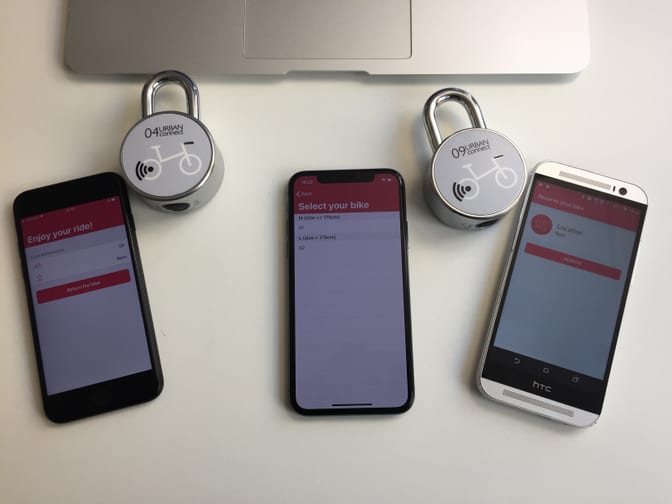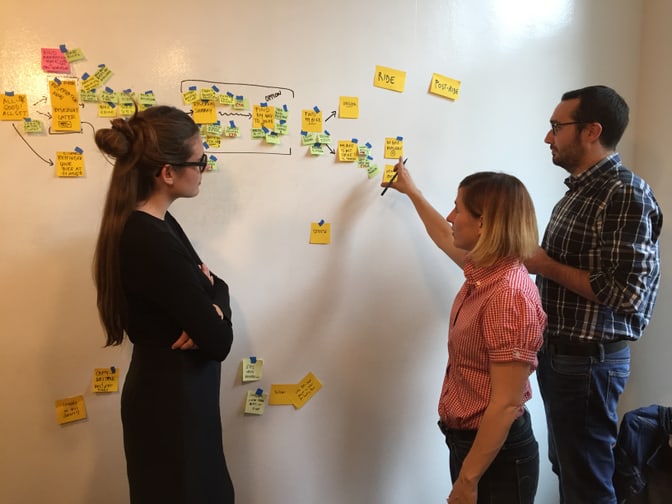Back in October, we kickstarted the relaunch of the Urban Connect bicycle fleet solution for their corporate clients (amongst which are Google and Avaloq). We provided the startup with User Experience, design, and mobile development services. The goal was to launch a brand new iOS and Android mobile app, as well as a new back-office and API. This new solution will enable the startup to grow its activity based on a robust and scalable digital platform.
The golive happened successfully last week — yeah!, and while we prepare our celebration lunch, I thought it is maybe interesting to share the challenges we faced during this purposeful project, and how we overcame them.
Make The User Use The App The Least Possible!
This product development was particular because we soon realized that for once, we were crafting a mobile app that should be used the least possible. That’s for a goal when all what we hear nowadays is about user retention and engagement.
The point is that Urban Connect service is about providing a bike solution with a smart lock that can be opened with your smartphone (via Bluetooth technology). People want to use it to book a bike and go from a point A to a point B, with the least friction possible — including with our mobile app software.
This key discovery was possible thanks to our UX workshops that focus on the user problems first. Concretely, it means that we went to the Google Zürich office to analyze and listen to how real users were using the solution, and which problems they had. That’s when we got that users wanted to use the app the least possible, and that it works automagically without getting their smartphone out of their pocket.
It’s only afterwards that we started to draw the first wireframes, and iterated on prototypes with Urban Connect and its clients to be sure that what we’re going to build was answering the real issues.
And finally, we developed and applied the user interface design layers.
This resulted in one of the Google users stating:
“Wow, that’s like a Tesla!
I never use the key, but it’s always there with me, and it just works.”
Again, we looked at the problems first, not at the design aspects. It may sound simple, but it still isn’t such a mainstream approach as one could think.
On Third-Party Smart Locks, Fancy Android Phones, and MVP
Most of the struggles we had to overcome were linked to the Bluetooth connectivity between the smart locks from Noke, and the Chinese Android devices.
The issues we faced with the Noke Smart Lock solution were that the company is still a startup, and as such, there are still some perks to their product such as outdated documentation, or hardware reliability.
Nevertheless, our solution was to not enter in a blame game party with them and Urban Connect, and rather contact them directly to fix the problems, one at a time. We must say that they were really responsive and helpful, so much that all of our main blockers were removed in less than a few days each time.
But that’s something to take into account in the planning and investment margin when you do estimation — thankfully we did!

As for the fancy Android phones, that’s the same story one hear everywhere: Android devices’ fragmentation sucks. We’re prepared to face such issues, and bought many different Android devices to be sure to have a good coverage.
Nevertheless, there are always corner cases such as a fancy Chinese phone with a specific Android ROM — one that is obviously not sold anymore to simplify the thing.
We overcame this issue thanks to a simple tool: communication. We didn’t play the blame game, and got in contact with the end user to figure out what was the problem on his device, so that we could understand it better.
Although communication is a good ally, its effect is the most effective when you start to use it as early as possible in the project.
As we use the Minimum Viable Product approach to develop our products, this allowed us to focus on this critical points upfront from day one, face them, and find solutions — vs. building the entire thing and being stuck at the golive with unsolvable issues.
Trustful Partnership as a Key to Success
On top of the usual UX and technical challenges that we face in every project, one key to the success of this product launch was the people involved. And the trustful collaboration between Urban Connect and us.
We faced many different challenges, from unexpected events, to sweats about planning deadlines (we made it on time, be reassured). And every single time, Judith and her team trusted us, as we did all along the way. Without this trust, we could have failed at many points during the project, but we both chose to remain in a solution-oriented mindset, and focus on the product launch goal. It proved to work, once again.

What’s next for Urban Connect?
Now that we happily pressed the “Go Live!” button, we’re first going to celebrate it properly around a nice lunch in Zürich. It was intense, but we love to work on such purposeful products which will help cities get more healthier thanks to less pollution and more physical activity for its users.
Then, we’ll have plenty of features to work on in 2018, including innovative ones like integrating IoT modules to the platform. We’ll make sure to share such new cool stuff with you.
In case you want to learn more about Urban Connect e-bike fleet service, feel free to contact Judith to get more infos and a demo of our solution.

